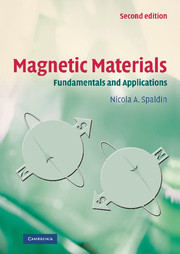Book contents
17 - Magnetic semiconductors and insulators
from III - Device applications and novel materials
Published online by Cambridge University Press: 05 June 2012
Summary
… quantized spins in quantum dots may prove to be the holy grail for quantum computing …
Stuart A. Wolf, Spintronics: Electronics for the next millennium? Journal of Superconductivity, 13: 195, 2000In this chapter we continue our survey of magnetic phenomena with a look at magnetism in magnetic semiconductors and insulators. A large practical motivation for the study of magnetic semiconductors is their potential for combining semiconducting and magnetic behavior in a single material system. Such a combination will facilitate the integration of magnetic components into existing semiconducting processing methods, and also provide compatible semiconductor–ferromagnet interfaces. As a result, diluted magnetic semiconductors are viewed as enabling materials for the emerging field of magnetoelectronic devices and technology. Because such devices exploit the fact that the electron has spin as well as charge, they have become known as spintronic devices, and their study is known as spintronics. In addition to their potential technological interest, the study of magnetic semiconductors is revealing a wealth of new and fascinating physical phenomena, including persistent spin coherence, novel ferromagnetism, and spin-polarized photoluminescence.
We will focus on the so-called diluted magnetic semiconductors (DMSs), in which some of the cations, which are non-magnetic in conventional semiconductors (Fig. 17.1 left panel), are replaced by magnetic transition-metal ions (Fig. 17.1 center panel). We will survey three classes of DMSs. First are the II–VI diluted magnetic semiconductors, of which the prototype is (Zn, Mn)Se, which have been studied quite extensively over the last decade or so.
- Type
- Chapter
- Information
- Magnetic MaterialsFundamentals and Applications, pp. 197 - 215Publisher: Cambridge University PressPrint publication year: 2010



